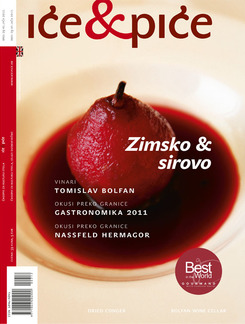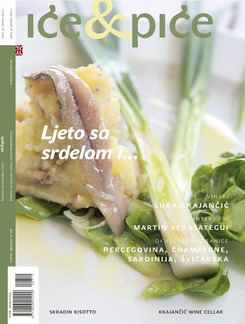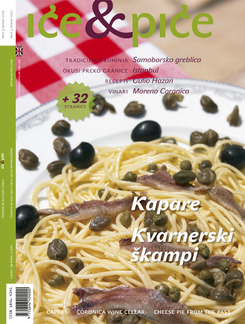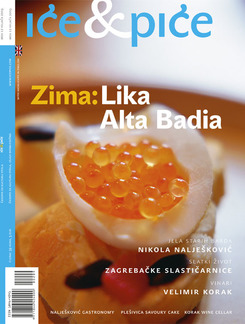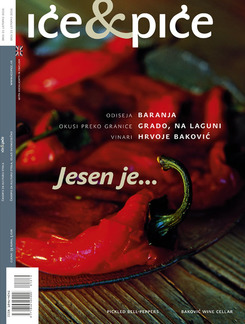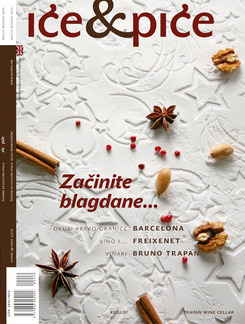My mum makes the best, the one and only, the unrepeatable French. But that’s not so uncommon, because your mum does the same. Friends and neighbours also boast of recipes for unforgettable French salad as served only and exclusively chez eux. Simply, whoever you might ask, the best French salad is made at their house, and everyone’s mum knows the best recipe. Some put in apples, others don’t believe in shop mayonnaise or they avoid peas. Whatever trick happens to be concerned, the fact is that French salad is one of those dishes that we eat with a deal of circumspection in someone else’s house. That first salad a la mum that we grew up with is the yardstick by which all others we shall meet are measured. Usually only a few times a year, at Christmas, Easter and birthdays, but then also on other occasions like weddings, christenings, wakes and the like. Luck would have it that it’s done infrequently enough for us not to be bored with it, and its status as a holyday dish remains unchallenged. French is a trump card in every New Year’s Eve dinner, because even if the crackling on the sucking pig is not crunchy enough, the salad can save the day. As for me, there need not be anything else on the table. Mum’s French salad is enough for the luck of the holyday table even if it is not decked with the symbolism of all the rest of the solemn fare. It’s not packed with meaning, like the pork that’s eaten on the last day of the year because one knows that the pig never goes backwards. Although rich, it doesn’t symbolise foison and prosperity like Easter eggs and decorated Easter and Christmas loaves. French salad is a petit bourgeois accompaniment of the table’s tragic hero, the remainder of an abandoned idea of cornucopia from some other time. A calorie-laden exclamation mark to all other intemperate holiday foods that force us to Lenten fare from January 1. As consolatory as meat balls in tomato sauce or cabbage rolls, French is the unused madeleine of Croatian letters.
From Russia with love
If we wanted to list all the Croatian national dishes, those that are made with passion in all the regional cuisines, the list would not be so great – perhaps just stuffed sour cabbage rolls, stuffed paprika, beans with bacon, hen and potatoes on Sunday, and of course, French salad, which has got no connection with France except through a Belgian cook who in the 1860s in the famed Moscow restaurant the Hermitage devised a salad of calf’s tongue, capers, lettuce, caviar and the other odd costly ingredient, all seasoned with mayonnaise. The creator of the distant ancestor of our French salad, Lucien Olivier, long managed to keep secret the exact recipe of his dressing, but as is usually the case with dishes that are fated to outlive their creator, the recipe was nicked. The story says, and it is not so important whether it is true or not, that one of the sous-chefs lay in wait for the moment for Olivier to leave the kitchen for a moment and then discovered all the ingredients of the dressing. Later he went to a new restaurant, tweaked the recipe a bit, and called it Stolichnaya (capital) salad. The thieving chef was called Ivan Ivanov, and he did not keep the recipe just for his own kitchen, but disseminated it among cheaper places. Now Russian or Olivier salad was there for everyone. In two decades, the original dish, modified indeed, got into private kitchens. At the end of the 19th century recipes for various modifications started to appear in Russian cook-books. Haute and vernacular cuisine developed two different versions. Practical middle-class kitchens replaced the expensive ingredients with cheaper, and in recipes of the early 20th century there are no mere caviar, dried duck breasts, lobsters or truffles. Select and expensive ingredients, the heart of Olivier’s prodigal salad, gave way to boiled vegetables, primarily potatoes, and cheaper cuts of meat, like boiled ham. So the robber-cook Ivanov can be thanked for a wonderful national dish. Olivier or Stolichnaya salad became known as Russian salad in the world at large, and in France is better known as macédoine de legumes. What is common to all versions, those with meat, as known in Iran, Serbia and Bulgaria, or with fish, as served in Spain, or vegetarian, prepared in Croatia, Poland, Pakistan and Turkey, is mayonnaise, French donation to world cooking.
How does a national dish come to be?
The rather involved story about French or rather Russian salad invented by a Belgian and popularised by a Russian that the French don’t call home but Macedonian salad appeared in Croatian cookery books at the end of the 19th century. This was a time when Russian serving and cuisines were in, and Austro-Hungarian cuisine kept up with fashion. This is shown by recipes in Kumičić’s Zagreb Cookery Book of 1888, like Russian soup, Russian pudding, and an illustration of a table laid a la russe. The oldest account of French salad can be found in Vučetić’s Cookery Book of the Zagreb Housekeeping School of 1935, but there are earlier confirmations in manuscript collections of recipes like that of Granny Iva, published as Granny Iva’s Cookbook or Samobor Bourgeois Cooking from the early 20th century. But the first French salads were pared down, stripped of any exaggeration and extravagance. Mere boiled potato, hardboiled egg and mayonnaise. Iva’s recipe is not much like today’s French or Russian salad. It is only a somewhat refined and elaborated potato salad, which is connected to France only by the mayonnaise. In cookery books of the 1940s or 1950s French salad is not to be found in today’s form, only potato salad dressed with mayonnaise. But from Kumičić’s to the cookbooks of the post-war period, Italian salad did appear, a dish of mixed vegetables with the addition of fish, moistened with mayonnaise. We conclude then that the omnipresent French of today is in fact a weird melange of Russian and Italian salads. On the whole mayonnaise starts vanishing from potato salad, and the Italian version of a salad with potato, beetroot, peas, pickled gherkins and eggs vanished, from both books and board. The most important factor in the dissemination and popularisation of French was the beginning of the industrial production of mayonnaise in the Zvijezda oil factory. When in 1965 mayonnaise made the move from tube to sachet, French salad could be made for very little money by anyone. Twenty years later, French salad was among the first meals-to-go on the Croatian market. It was and still is a vile ersatz of the favourite holiday dish, but it can’t be denied that it was the industrial version that helped in the standardisation of the dish at the national level. French is made today at Dalmatian and Slavonian weddings, it’s enjoyed in Međimurje and Lika, and just how deeply entrenched is the Croatian love for French is witnessed by everyone’s mum being the best at making it. Although it has not entered the traditional Christmas vocabulary, it’s still an indispensable part of the New Year table, the communist culmination of the year the menu of which was supposed to throw turkey and trimmings into the shade. For fifty years the gastronomic climax of the year was summed up in the plethora of ingredients in French salad, even if it did not contain any excessive bourgeois provisions. Just the ideologically neutral potato, carrot, pea and egg. For practical reasons, the preparation of French salad was connected with cooking huge pots of soup. The excess soup veggies could be used for the French, and so it seems to me that French is a logical consequence of beef consommé and the reason that we haven’t given up on homemade pickled gherkins. Not even sloth is today a reason for giving up on the dish, because there’s no need to have to dice the vegetables. There are frozen packs of diced vegetables for French that just have to be cooked through, and then you have to dice the gherkins and open the mayonnaise. From a signature dish for favoured customers, then the jewel on the table of socialist celebration, French salad has become a traditional dish that can today be made by every bungler. But alas, it won’t be quite like mum’s.
